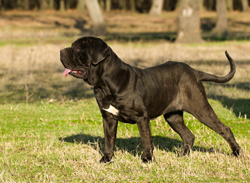Neapolitan Mastiffs are very large dogs known for their size, loose skin, and abundant wrinkles. Their coat is short, straight, and dense and comes in gray-blue, mahogany, black, and tawny. There may be some white markings and brindling. These dogs have deep-set eyes, drooping upper lids, and large noses. Neapolitan Mastiffs measure 24 to 31 inches tall at the shoulder and weigh 110 to 150 or more pounds.
They should not be left outdoors in hot weather, and they need access to cool water and plenty of shade when playing outside with family.
Despite their scary appearance and serious attitude, these dogs are friendly and peaceful. However, because of their size and temperament, this breed is not ideally suited to first-time dog owners or families with young children.
Neapolitan Mastiffs enjoy the cold, but they are very sensitive to heat. They should not be left outdoors in hot weather, and they need access to cool water and plenty of shade when playing outside with family. Exercise should be limited to mornings and evenings, when the temperature outside is lower.
Neapolitan Mastiffs are very loyal to their human family members, and they typically act like guardians around strangers. These dogs were born and bred to be protectors, and they take their role very seriously. They form strong bonds with their family and are skilled at reading people's emotions.
Although these dogs may seem aloof at times, they need a lot of affection and attention to be happy. They enjoy games, walks, and cuddling, and they will become depressed if ignored or neglected, even for a short period. Taking them for a walk on a leash is a great way to spend time with these dogs while encouraging physical activity.
This is an inside breed, and chaining these dogs out in the yard will only lead to destructive and aggressive behavior. Some outdoor time is beneficial, provided the weather is cool, but it's important to keep these dogs in a securely fenced yard. Electronic fences cannot contain Neapolitan Mastiffs; a high fence is required.
Neapolitan Mastiffs are prone to a number of health conditions that may negatively affect length or quality of life. Common health issues in the breed include elbow and hip dysplasia, hypothyroidism, and cardiomyopathy, a heart condition. Osteosarcoma, a type of bone cancer, is also known to affect these dogs.
Eye disorders, such as entropion, ectropion, cherry eye, and progressive retinal atrophy, are more common in Neapolitan Mastiffs than in some other breeds. Additionally, these dogs are prone to bloat and gastric torsion. Feeding them several smaller meals throughout the day instead of one or two larger meals will help prevent these conditions from developing.
With routine veterinary care, a balanced diet, regular exercise, and timely canine vaccinations, Neapolitan Mastiffs typically live up to 10 years.
Neapolitan Mastiffs are not the easiest dogs to live with or train, and they are not the best choice for first-time dog owners. These dogs need an experienced trainer who can teach them with firm, but kind, training methods. Neapolitan Mastiffs do not respond well to harsh criticism, cruelty, or force. To ensure training success, patience, routine, and positive reinforcement are crucial.
This breed needs plenty of socialization to prevent overly fearful or suspicious behavior. To grow into tolerant adults, Neapolitan Mastiffs should attend a puppy kindergarten class before they reach 12 weeks of age. Dog parks should be avoided later in life, though, as these dogs tend to be naturally aggressive toward unfamiliar dogs.
Neapolitan Mastiff puppies like to chew and can cause a great deal of destruction if this behavior is not dealt with. Additionally, young and adolescent dogs should not be given the run of the house. Keeping this breed busy and providing proper training is key to preventing negative behaviors.
Neapolitan Mastiffs need brushing or combing every day to keep their skin and coat healthy and to remove dead hair that may otherwise end up on clothing and furniture. Beginning a grooming routine early in life will prevent resistance later.
These dogs have naturally oily skin that can cause a musky odor. Regular baths with a pH-balanced canine shampoo will reduce oil accumulation and odor. Additionally, these dogs need their wrinkles cleaned daily with a damp cloth and then dried thoroughly to prevent infection. Wiping their mouth after drinking and periodically throughout the day will cut down on mess caused by drooling and slobbering.
The breed's nails need trimming every couple of weeks, and the teeth should be brushed daily with a canine toothpaste and toothbrush. About once weekly, the ears should be examined for excess ear wax and signs of infection, such as odor, discharge, or redness. If cleaning is necessary, a cotton ball dampened with a veterinarian-approved otic cleanser will do the trick.
The Neapolitan Mastiff is an ancient breed with lineage dating back to ancient Egypt, Mesopotamia, Persia, and Asia. The Roman army used the breed as dogs of war, and evidence exists that Alexander the Great helped mold the breed into its dignified and intimidating form in 300 B.C.
Later, these dogs were primarily used to defend property on farms in Italy. The breed's large and imposing appearance made them very effective in this role. However, over time, the breed's popularity decreased and its numbers dwindled.
Neapolitan Mastiffs were rediscovered in Italy during the 1940s and are now considered a national treasure in that country. In Italy, the United States, and elsewhere, these dogs are primarily kept as farm dogs and pets. They can also be found in show rings all over the world.
The Neapolitan Mastiff was officially recognized by the American Kennel Club in 2004.

